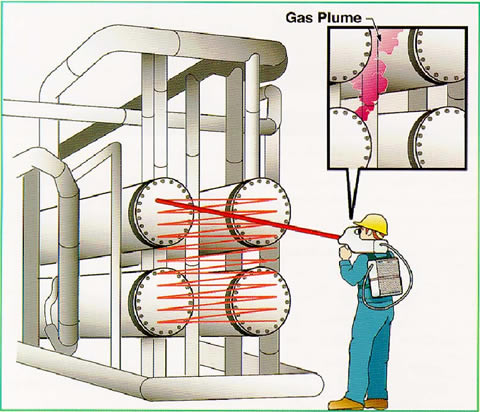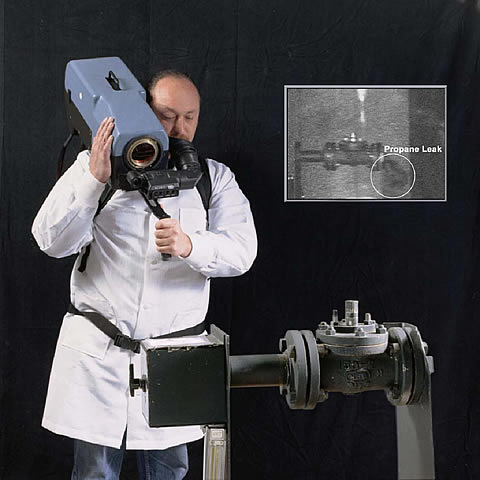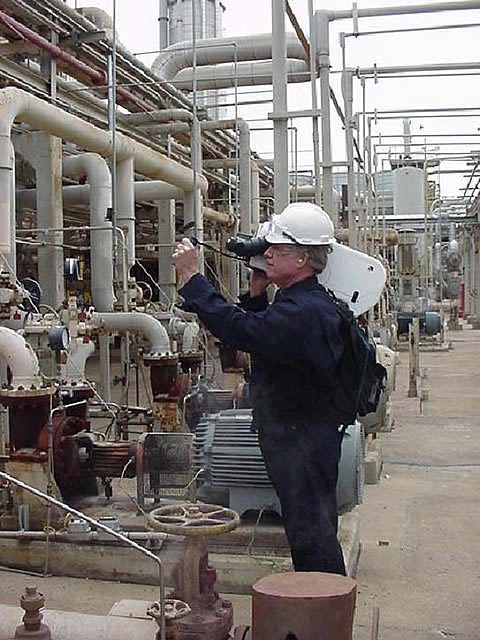Hydrocarbons do not absorb light at visible wavelengths and are not seen by the eye. They do, however, absorb in the infrared (IR) and are viewable at specific wavelengths absorbed by the gas. Two methods of IR gas imaging exist-passive and active. The former views a scene using thermal IR radiation emitted by the gas and scene. The latter illuminates the scene using laser light absorbed by the gas as it images the scene using backscattered light. The intensity of the passive gas image depends on the temperature difference between the gas and scene, as well as on plume thickness and concentration. Active imaging has no temperature dependence and thus was selected to be used in this project.
Active gas imaging devices were being produced for commercial sale by LIS at the initiation of this project; however, those devices used CO2 lasers whose emission wavelengths (9-11 µm) are not absorbed by hydrocarbons relevant to the petroleum industry. Thus, a critical challenge faced by this project was the creation of a laser emitting at the mid-IR wavelengths (3.1-3.6 µm) that are absorbed by hydrocarbons, while meeting the size and efficiency requirements of an operator-portable system.
Results
In the course of this project, an operator-portable backscatter-absorption gas imaging (BAGI) system was developed to produce real-time video imagery of numerous organic vapors of interest to the petroleum (and other) industries. The imager was shown to operate effectively at several field trials at petroleum processing facilities in the United States and abroad. The results serve as the basis of an EPA rule-change application submitted by API requesting that gas imaging be allowed as an alternative work practice to the established EPA Method 21, which dictates how leak surveillance is conducted. That rule change is now under consideration.
Benefits
Hydrocarbons emitted by petroleum refineries generate smog and produce urban ozone. Thus the EPA actively regulates the emission of hydrocarbons by processing facilities. Leak detection and repair (LDAR) programs are operated by major facilities to comply with these regulations.
By making a gas plume "visible" to its operator, the gas imager offers an efficient and effective alternative to EPA Method 21, which describes the use of handheld "sniffer" sensors to detect leak presence and magnitude. Sniffers imprecisely infer leak flux (in grams per hour, or g/hr) from point concentration (parts per million, or ppm) measurements. Leaks are missed if the probed point does not intersect the vapor plume. Finally, LDAR programs using sensors that must be manually brought in close proximity to the leak point are laborious and expensive (~$1 million per year at large refineries). Gas imaging instantly covers a large area, thus ensuring that the leak point is in the measurement zone, allowing many points to be probed simultaneously, and providing a visual indication of leak flux.
Project researchers have:
- Developed a van-mounted hydrocarbon gas imager.
- Demonstrated the imager's performance in a Texas oil refinery (April 1999).
- Developed an operator-portable, battery-powered hydrocarbon gas imager.
- Conducted laboratory tests in support of an EPA rule-change submission.
- Conducted the following field trials:
- California petroleum refinery (January 2003).
- Texas petroleum refinery (February 2003).
Petrochemical lab tests-BP at Naperville, IL (August 2003).
- Southampton, U.K., petroleum refinery demonstration (September 2003).
- Texas petroleum refinery test (January 2004).
- Texas petrochemical plant tests (February 2004).
Infrared lasers for both the van-mounted and operator-portable imagers were constructed by coupling efficient nonlinear frequency converters to diode-pumped solid-state pump lasers. The former employed nonlinear optical crystals to convert light at the pump frequency to tunable radiation in the mid-IR. The first pump laser used was a water-cooled Nd:YAG laser suitable for use in the van-mounted configuration. The operator-portable imager employed a significantly smaller pump consisting of a miniature Nd:YAG laser amplified by a fiber-optic amplifier. This allowed creation of an operator-portable system capable of operating for >2 hours on battery power. At field trials, it was demonstrated to successfully image gas leaks at ranges up to 30 feet and detection limits corresponding to leak rates of ~2-60 g/hr of hydrocarbons.






